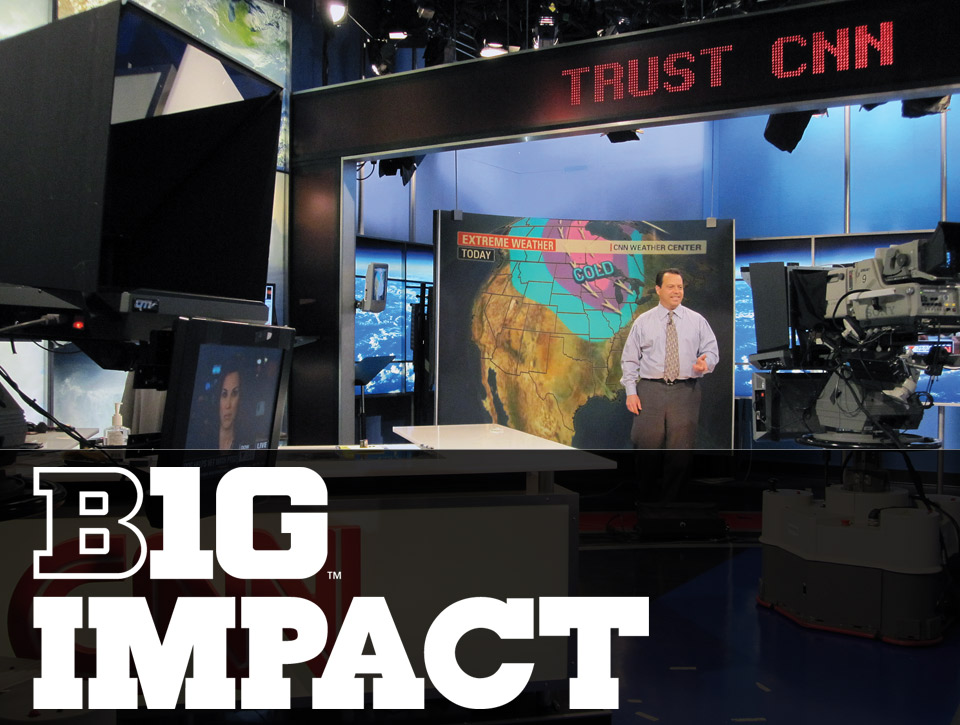
He’s one of the most widely known TV weathermen on Planet Earth.
Instantly recognizable as a CNN “weather anchor” and “severe weather expert,” Chad Myers has spent the past decade alerting the nation to the threat from tornadoes, hurricanes, floods, forest fires and creeping drought while also directing CNN’s intrepid team of roving weather correspondents. His overriding goal, as a major American weather guru: “to help as many people as I can, by getting it right.”
The bulletin from the National Weather Service (NWS) was crystal-clear … and terrifying.
Top sustained wind speeds now in excess of 130 miles an hour, with wave heights of 70 feet or more. This is an extremely dangerous storm, with the potential for massive, life-threatening flooding. …
It was two a.m. on the 29th of August, 2005.
Staring at the computer printout in his hand, CNN Weather Anchor Chad Everett Myers (B.S. ’87) shook his head in disbelief.
There could be no more doubt: the great American city at the mouth of the Mississippi was about to take a monster hit from what would eventually prove to be the most destructive hurricane in U.S. history.
Katrina was about to blast her way through New Orleans, and there was nothing anybody could do about it.
Chad Myers groaned and rubbed his eyes. For the past several hours, the veteran Cable News Network weatherman had been warning coastal residents from Texas to Florida that they faced a potentially catastrophic threat from the fearsome winds and cresting storm surge of a titanic force of nature.
Born six days earlier among the tropic breezes and sun-dappled expanses of the Atlantic Bahamas region, Katrina had already crossed southern Florida as a moderate “Category 1” hurricane. But then, after spinning westward into the heat-soaked Gulf of Mexico, the storm had quickly morphed into a “Category 5” Frankenstein – a churning, 200-mile-wide juggernaut with the inconceivable power of 50,000 exploding atomic bombs.
At two o’clock on this historic morning in late September, the storm’s trajectory was
alarmingly evident. The Big Easy was going to take the blow nearly head-on … and her fragile interlocking system of dikes, canals and sand-bagged levees was about to be tested to the max.
For Myers, a former UNL geography/meteorology major who’d already been working as a CNN forecaster for six years, this would be “the toughest and most grueling” on-camera stint ever.
During 14 straight hours of uninterrupted coverage, Myers remained on the weather set at the cable channel’s huge nerve center in Atlanta. Again and again, he delivered the warnings that were arriving every few minutes from the NWS, the Federal Emergency Management Agency (FEMA) and state and local officials located all along the Gulf Coast.
In between the warnings, the well-known TV weatherman directed the movements of 20 different CNN reporters who were covering the story with camera crews and satellite trucks – and who were now hunkered down at coastal locales in Texas, Louisiana, Mississippi and Alabama.
“I was playing quarterback that night,” recalls the “severe weather expert” for the world’s largest cable news operation. “From beginning to end, I was responsible not only for directing the coverage by ‘throwing’ to [switching to] our correspondents out there in the storm, but also for trying to make sure we didn’t lose anybody.
“I’m not exaggerating when I tell you that some of our people’s lives were at stake that night. And that fact weighed heavily on me. I remember at one point around dawn, I had Weathering the Storm[reporters] Miles O’Brien and Anderson Cooper on a beach, and I got word that the wind speeds there had just topped 130 miles an hour.
“I didn’t hesitate. I grabbed the phone and I started hollering at Anderson: ‘you need to get in the car and leave!’
“And he comes right back at me. He yells: ‘We can’t, we’re doing a live shot!’
“And I just went ballistic. I roared at him: ‘you heard me – get everybody in the truck and go!’
“And they did. I nearly had a heart attack … but I finally managed to get them off that beach and far enough inland that they wouldn’t get washed away by the waves. We had put them in peril, and I was absolutely determined to make sure they got out of there and got back safely to their families.”
In the end, all of the CNN correspondents survived the sixth-strongest and most destructive hurricane (latest total damage estimate: $100 billion) in the nation’s history.
Tragically, the same thing can’t be said for the estimated 2,000 Gulf Coast residents
(most in New Orleans) who perished on that fateful day four and a half years ago.
Describing his 14-hour shift that night, Chad Myers shakes his head in remembered
amazement. “It was mind-numbing, to say the least. Hour after hour, I stayed on camera – from about ten p.m. on Sunday night until noon the next day. And there were a few times when I didn’t know if I’d make it. I got light-headed, dizzy … and I didn’t eat for 12 hours.
“I’ve covered at least a dozen hurricanes during my ten years at CNN, but nothing will ever compare with the struggle we went through in reporting what we now think of as the storm of the century.
More details at: http://huskeralum.com/communications/nebraska_magazine/documents/09winter/WeatheringTheStorm.pdf